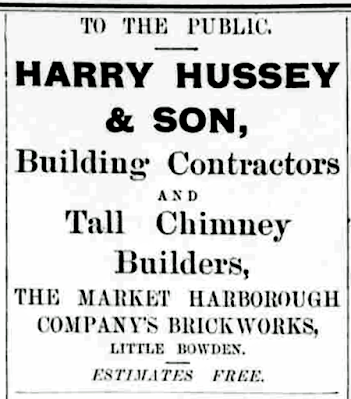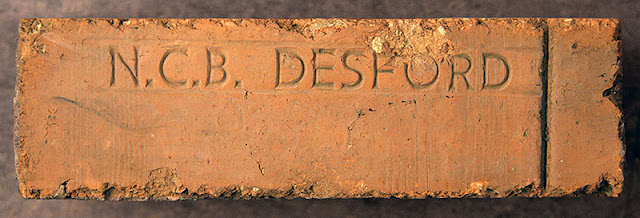East Midlands Named Bricks
Tuesday, 25 March 2025
Leicestershire Brickworks - part 5
Tuesday, 4 February 2025
Leicestershire Brickworks - part 4
The 1881 OS map shows Heather Colliery & it's associated brickworks was accessed off Pisca Lane (brickworks coloured red on the 1901 map above - colliery a little further north), but there are no trade directory entries for this brickworks at this date. It is not until 1891 when the colliery & brickworks was re-opened as the New Heather Colliery Co. that this company is listed in the Brick Manufacturers section of Kelly’s 1891 edition with Henry Slater Wooley recorded as proprietor. Henry Wooley lived at Highfield House on Station Road (coloured blue). This house still stands today. I suspect the brick below will have been made by the New Heather Colliery Co.
Heather Colliery closed in 1896 due to flooding & low coal reserves, but we find the brickworks had been sold off before then with Kelly’s 1895 recording the Heather Brick & Terra Cotta Co. proprietor, Henry J. Ford now owned this brickworks.
This Heather Brick & Terra Cotta Co. entry continues in trade directories until Kelly's 1922 edition when the entry now records Ford had purchased Wains Brick & Terra Cotta Works (coloured yellow) after Wains had closed down. I cover Andrew Wain's works next. Ford continues to run both works up to c1930 with Kellys 1928 edition being the last entry for the Heather Brick & Terra Cotta & Wains Co. (red & yellow works). We next find the Coronet Brick & Terra Cotta Co. in Measham, purchased both these works around 1930. Kelly's 1932 edition is the first directory listing Coronet's Heather works.
This BCM Heather brick will have been made at the Pisca Lane works when owned by Coronet. The Coronet 1937 advert below records Coronet's three works & that BCM stands for British Commercial Monomarks, a company established in 1925 to provide manufacturers with a London address & mail forwarding services. It was an early form of the Post Code we use today, but companies & individuals back then had to pay for this service. It was with this advert being forwarded to me by Paul & Cynthia that I was able to reveal to the brick fraternity that BCM stood for British Commercial Monomarks & not British Clay/Ceramic Manufacturers as thought for many years without any written evidence turning up for this explanation of the initials. So another thumbs up to me for bring this evidence to the brick fraternity. If you would like to learn more about BCM please visit Mark Cranston's article. It is unknown in which year this Pisca Lane Works closed under Coronet.


The first reference found relating to this green coloured brickworks appears in the London Gazette dated 9th of July 1897, in which John French Neal & John Thomas Jacques were dissolving their partnership on the 5th of July 1897 & had operated as Neal & Jacques, Brickmakers, in Heather, Leicestershire. All debts due to & owing by the said company would be received & paid by John F. Neal. It is unknown in which year Neal & Jacques had established their brickworks, but they are not listed in Kelly's 1895 edition & this works is not shown on the 1881 OS map. John French Neal then went on to run this works on his own with Kelly's 1899 & 1900 editions recording John French Neal at 2a, Halford Street, Leicester, offices; works, Heather.
As you can see on the 1900 OS map above this works had road access from Newton Road & footpath access from Mill Lane, both are coloured green. It's not until the 1927 map that it shows this works had road access via Station Terrace (blue dotted line) from Mill Lane. Again I found some anomalies because later company's operating this works give their address of Station Road when it was actually off Mill Lane. I then found in the 1970's after the disused railway line had been removed, a new road was built to access this works, coloured purple. This road is still there today & it will give access to whatever they build on this former brickworks site. As I have digressed I now return to John French Neal & after finding two badly damaged bricks made by Neal I came across this mint example at 4 Oaks Reclamation.
John French Neal b.1860 is listed in the 1901 census as a Brick Manufacturer, aged 41, wife, Clavender (nee Pearson m. 1882) & with one son John P. Neal, aged 18, living at Bardon Hill House, Bardon. The 1901 edition of the Directory of Clayworkers records Neal was making Red hand-pressed bricks, facing bricks, tiles & terra cotta. I next found Bennett's 1901 trade directory records the partnership of Neal & Jacques, Brick Manufacturers in Heather once more & this find is followed by a Derbyshire Records Office reference from the web which reveals that in 1901 Neal's business had been incorporated as Neal & Co. Limited. So from this info it appears Neal & Jacques joined forces again & then started a new company called Neal & Co. This Derbyshire Records Office article then states in 1903 the company changed it's name to the National Brick Company Limited.
I next found three London Gazette Notices which record John French Neal had declared himself bankrupt on the 25th of March 1904 or had a bankruptcy petitioned declared against him on the 24th May 1906. Neal is listed as Brick & Tile Manufacture & a Builders Merchant's Traveller with him having a second home in Kilburn, London. Now I do not know how this affected the National Brick Co. as this notice does not name this company. My only thought's are that Neal himself was declaring himself bankrupt rather than the Company. The notice dated 30th of April 1907 which records Neal had declared himself bankrupt also tells you that he is now deceased, so John died some time between May 1906 & April 1907. I can only assume other directors/shareholders were running the National Brick Co. which may have included John Thomas Jacques as you will next read next was still associated with the company.
Kelly's 1908 edition records The National Brick Co. Heather, Ashby-de-la-Zouch with John T. Jacques as manager. This entry is repeated in Kelly's 1912 & 16 editions.
After WW1 we find Kelly's 1922 & 25 editions now record John T. Jacques as Managing Director of the National Brick Co. Heather. Kelly's 1925 edition also records National were now operating the Hermitage Brickworks in Whitwick as well, previously owned by H.R. Mansfield. The 1932 to 41 directories list both brickworks with the address for the Heather Works is given as Station Road & as previously wrote this works was actually accessed off Mill Lane.
My next find is the 1959 advert below in which it states the Star Brick & Tile Company of Ponthir, Newport, South Wales was an Associated Company. Star was a large concern & owned several brickworks in South Wales. We then find at a date unknown National & Star amalgamated forming the National Star Brick Co.
The next change at the National Star Brick Co. is when Butterley/Hanson Group purchased it in 1971. It appears Butterley continued to operate this new Group in it's own name with the Brickworks of Wales website stating National Star Limited of Newport, South Wales were still operating under this name in 1978. Whether the Heather & Whitwick works were still operating under the National Star name is unknown, but I suspect these two works changed their name to Butterley with them being close to Butterley's headquarters in Ripley, Derbyshire. Butterley's Heather Works closed in 2012 & the site is awaiting to be redeveloped, but it is unknown when the Hermitage Brickworks in Whitwick closed.

































































